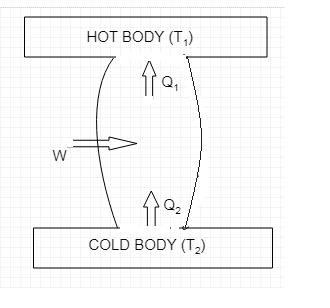
Draw schematic diagram of a refrigerator. Define its coefficient of performance and mention the expression.
Answer
464.7k+ views
Hint: A device which takes heat from a cold body and transfers it to a hot body is called a refrigerator. It does the reverse of a heat engine. Work by the external agent must be done so that the process of refrigeration goes on. First we will draw the schematic diagram of a refrigerator and from that we will define the coefficient of performance of the refrigerator.
Complete answer:
The schematic diagram of a refrigerator is shown below.

As we can see from the diagram it takes ${{Q}_{2}}$ amount of heat from the cold body which is at a lower temperature of ${{T}_{2}}$. $W$ amount of work is done by the external agent and a total of
${{Q}_{1}}={{Q}_{2}}+W$ amount of heat is given to the hot body which is at a higher temperature of ${{T}_{1}}$.
The purpose of a refrigerator is to remove as much heat from the cold body at the expense of as little work required to run the refrigerator. Thus the coefficient of performance $K$ of a refrigerator is defined as the ratio of the heat taken from the cold body to the amount of work required to run the refrigerator, Thus
$K=\dfrac{{{Q}_{2}}}{W}$.
Now
$\begin{align}
& {{Q}_{1}}={{Q}_{2}}+W \\
& or\dfrac{W}{{{Q}_{2}}}=(\dfrac{{{Q}_{1}}}{{{Q}_{2}}}-1) \\
\end{align}$
Now as in Carnot’s engine, if we use ideal gas as a working substance then it can be shown
$\dfrac{{{Q}_{1}}}{{{Q}_{2}}}=\dfrac{{{T}_{1}}}{{{T}_{2}}}$, thus
$\dfrac{W}{{{Q}_{2}}}=(\dfrac{{{T}_{1}}}{{{T}_{2}}}-1)=(\dfrac{{{T}_{1}}-{{T}_{2}}}{{{T}_{2}}})$
Therefore the coefficient of performance
$K=\dfrac{{{Q}_{2}}}{W}=\dfrac{{{T}_{2}}}{{{T}_{1}}-{{T}_{2}}}$
Note:
A refrigerator can have a coefficient of performance greater than 1. In a heat engine, heat cannot be fully converted to work, similarly a refrigerator cannot work without some external work done on the system i.e. the coefficient of performance cannot be infinite. A good refrigerator should have its value around 5 or 6.
Complete answer:
The schematic diagram of a refrigerator is shown below.

As we can see from the diagram it takes ${{Q}_{2}}$ amount of heat from the cold body which is at a lower temperature of ${{T}_{2}}$. $W$ amount of work is done by the external agent and a total of
${{Q}_{1}}={{Q}_{2}}+W$ amount of heat is given to the hot body which is at a higher temperature of ${{T}_{1}}$.
The purpose of a refrigerator is to remove as much heat from the cold body at the expense of as little work required to run the refrigerator. Thus the coefficient of performance $K$ of a refrigerator is defined as the ratio of the heat taken from the cold body to the amount of work required to run the refrigerator, Thus
$K=\dfrac{{{Q}_{2}}}{W}$.
Now
$\begin{align}
& {{Q}_{1}}={{Q}_{2}}+W \\
& or\dfrac{W}{{{Q}_{2}}}=(\dfrac{{{Q}_{1}}}{{{Q}_{2}}}-1) \\
\end{align}$
Now as in Carnot’s engine, if we use ideal gas as a working substance then it can be shown
$\dfrac{{{Q}_{1}}}{{{Q}_{2}}}=\dfrac{{{T}_{1}}}{{{T}_{2}}}$, thus
$\dfrac{W}{{{Q}_{2}}}=(\dfrac{{{T}_{1}}}{{{T}_{2}}}-1)=(\dfrac{{{T}_{1}}-{{T}_{2}}}{{{T}_{2}}})$
Therefore the coefficient of performance
$K=\dfrac{{{Q}_{2}}}{W}=\dfrac{{{T}_{2}}}{{{T}_{1}}-{{T}_{2}}}$
Note:
A refrigerator can have a coefficient of performance greater than 1. In a heat engine, heat cannot be fully converted to work, similarly a refrigerator cannot work without some external work done on the system i.e. the coefficient of performance cannot be infinite. A good refrigerator should have its value around 5 or 6.
Recently Updated Pages
Glucose when reduced with HI and red Phosphorus gives class 11 chemistry CBSE

The highest possible oxidation states of Uranium and class 11 chemistry CBSE

Find the value of x if the mode of the following data class 11 maths CBSE

Which of the following can be used in the Friedel Crafts class 11 chemistry CBSE

A sphere of mass 40 kg is attracted by a second sphere class 11 physics CBSE

Statement I Reactivity of aluminium decreases when class 11 chemistry CBSE

Trending doubts
10 examples of friction in our daily life

One Metric ton is equal to kg A 10000 B 1000 C 100 class 11 physics CBSE

Difference Between Prokaryotic Cells and Eukaryotic Cells

State and prove Bernoullis theorem class 11 physics CBSE

What organs are located on the left side of your body class 11 biology CBSE

How many valence electrons does nitrogen have class 11 chemistry CBSE




